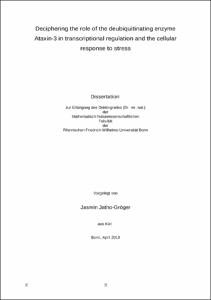Jatho-Gröger, Jasmin: Deciphering the role of the deubiquitinating enzyme Ataxin-3 in transcriptional regulation and the cellular response to stress. - Bonn, 2018. - Dissertation, Rheinische Friedrich-Wilhelms-Universität Bonn.
Online-Ausgabe in bonndoc: https://nbn-resolving.org/urn:nbn:de:hbz:5n-52912
Online-Ausgabe in bonndoc: https://nbn-resolving.org/urn:nbn:de:hbz:5n-52912
@phdthesis{handle:20.500.11811/7684,
urn: https://nbn-resolving.org/urn:nbn:de:hbz:5n-52912,
author = {{Jasmin Jatho-Gröger}},
title = {Deciphering the role of the deubiquitinating enzyme Ataxin-3 in transcriptional regulation and the cellular response to stress},
school = {Rheinische Friedrich-Wilhelms-Universität Bonn},
year = 2018,
month = dec,
note = {Ataxin-3 (ATXN3), the disease-causing protein for Machado Joseph Disease (MJD) is functionally involved in the protein quality control and transcriptional regulation of various genes. Recent data suggest that either conformational changes of the expanded ATXN3 protein and/or a loss of free available ATXN3 due to recruitment of ATXN3 into aggregates leads to the dysregulation of multiple cellular pathways such as ubiquitination or transcriptional regulation. In this study, induced pluripotent stem cells (iPSCs) were used to decipher the influence of expanded and/or lost ATXN3 on gene expression in patient-specific neurons. To that end isogenic iPSC-derived neural stem cell lines were generated, expressing the normal (ATXN3_non-exp), the expanded (ATXN3_exp) or no ATXN3 (ATXN3_KO) using CRISPR/Cas9-mediated gene editing. This approach allowed a direct comparison of the gene expression profiles between the expanded/KO and non-expanded allele of ATXN3 within an isogenic genetic background. By transcriptional profiling of neurons generated from these lines identified several genes were identified, which were dysregulated in ATXN3_exp and ATXN3_KO neurons. Among those a cluster of metallothioneins (MTs) was found, which was significantly downregulated in ATXN3_exp and ATXN3_KO neurons compared to those cells with the non-expanded form of ATXN3. Physiologically, MTs are important regulators of cell homeostasis and participate in an array of protective responses against oxidative, metal and excitotoxic stress. Consequently, it was discovered that ATXN3_exp and ATXN3_KO neurons are more susceptible to several types of cellular stress. Furthermore, these neurons displayed a higher level of total ROS and superoxide under oxidative stress compared to ATXN3_non-exp neurons. As a possible underlying mechanism this thesis suggests a posttranslational interaction between ATXN3 and metal transcription factor 1 (MTF-1) for the regulation of the gene expression of MTs via the deubiquitinating function of ATXN3. So far, increased MTF-1 protein levels in ATXN3_non-exp neurons in comparison to ATXN3_KOs support this idea. But these are preliminary data and whether ATXN3 regulates responses to various stressors by interacting with MTF-1 remains to be demonstrated, however in the frame of this work a strong genetic neuronal model was generated that supports a correlation between ATXN3 and MT expression. Furthermore, this work confirms that ATXN3 plays an important role in regulating the cellular stress response and that an increased susceptibility towards stress and the correlating decreased anti-oxidative defense contributes to neuronal cell death and thus to the pathogenesis of Machado Joseph Disease.},
url = {https://hdl.handle.net/20.500.11811/7684}
}
urn: https://nbn-resolving.org/urn:nbn:de:hbz:5n-52912,
author = {{Jasmin Jatho-Gröger}},
title = {Deciphering the role of the deubiquitinating enzyme Ataxin-3 in transcriptional regulation and the cellular response to stress},
school = {Rheinische Friedrich-Wilhelms-Universität Bonn},
year = 2018,
month = dec,
note = {Ataxin-3 (ATXN3), the disease-causing protein for Machado Joseph Disease (MJD) is functionally involved in the protein quality control and transcriptional regulation of various genes. Recent data suggest that either conformational changes of the expanded ATXN3 protein and/or a loss of free available ATXN3 due to recruitment of ATXN3 into aggregates leads to the dysregulation of multiple cellular pathways such as ubiquitination or transcriptional regulation. In this study, induced pluripotent stem cells (iPSCs) were used to decipher the influence of expanded and/or lost ATXN3 on gene expression in patient-specific neurons. To that end isogenic iPSC-derived neural stem cell lines were generated, expressing the normal (ATXN3_non-exp), the expanded (ATXN3_exp) or no ATXN3 (ATXN3_KO) using CRISPR/Cas9-mediated gene editing. This approach allowed a direct comparison of the gene expression profiles between the expanded/KO and non-expanded allele of ATXN3 within an isogenic genetic background. By transcriptional profiling of neurons generated from these lines identified several genes were identified, which were dysregulated in ATXN3_exp and ATXN3_KO neurons. Among those a cluster of metallothioneins (MTs) was found, which was significantly downregulated in ATXN3_exp and ATXN3_KO neurons compared to those cells with the non-expanded form of ATXN3. Physiologically, MTs are important regulators of cell homeostasis and participate in an array of protective responses against oxidative, metal and excitotoxic stress. Consequently, it was discovered that ATXN3_exp and ATXN3_KO neurons are more susceptible to several types of cellular stress. Furthermore, these neurons displayed a higher level of total ROS and superoxide under oxidative stress compared to ATXN3_non-exp neurons. As a possible underlying mechanism this thesis suggests a posttranslational interaction between ATXN3 and metal transcription factor 1 (MTF-1) for the regulation of the gene expression of MTs via the deubiquitinating function of ATXN3. So far, increased MTF-1 protein levels in ATXN3_non-exp neurons in comparison to ATXN3_KOs support this idea. But these are preliminary data and whether ATXN3 regulates responses to various stressors by interacting with MTF-1 remains to be demonstrated, however in the frame of this work a strong genetic neuronal model was generated that supports a correlation between ATXN3 and MT expression. Furthermore, this work confirms that ATXN3 plays an important role in regulating the cellular stress response and that an increased susceptibility towards stress and the correlating decreased anti-oxidative defense contributes to neuronal cell death and thus to the pathogenesis of Machado Joseph Disease.},
url = {https://hdl.handle.net/20.500.11811/7684}
}






